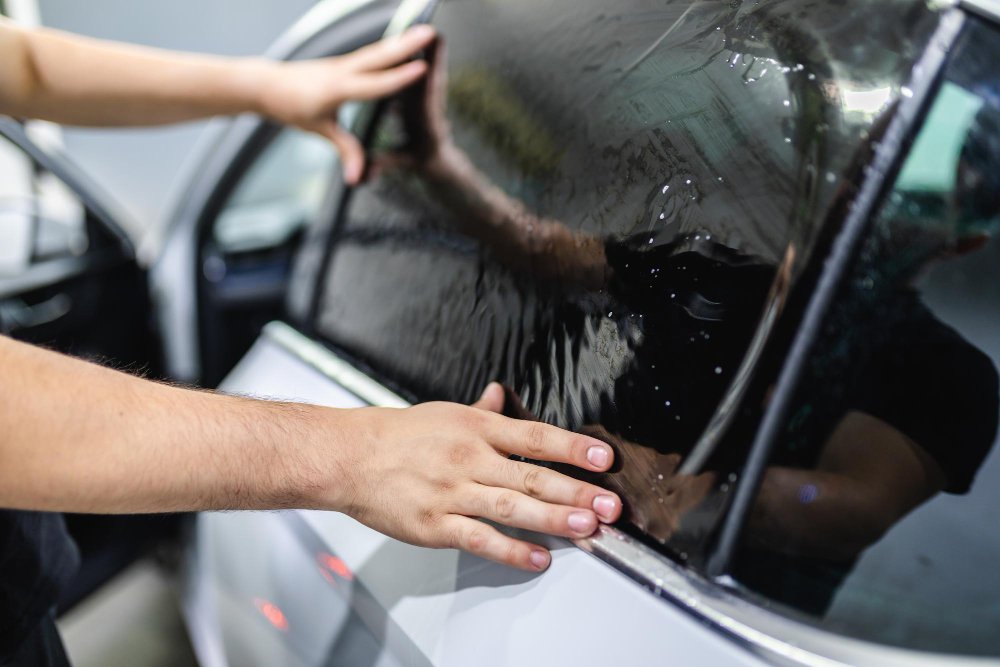Custom Auto Window Tinting Services for a Streamlined and Fashionable Appearance
Custom Auto Window Tinting Services for a Streamlined and Fashionable Appearance
Blog Article
Home Window Tinting Laws and Standards: What You Need to Know Before Tinting Your Cars And Truck
Before proceeding with home window tinting for your vehicle, it is important to familiarize yourself with the varied regulations and standards that govern this technique across different states. These policies dictate the allowable levels of color darkness, typically gauged by visible light transmission (VLT) portions, and consist of specific specifications for front windshields aimed at making certain roadway safety.
Introduction of Home Window Tinting Regulations
Window tinting regulations are regularly based on variant across different territories, mirroring neighborhood policies and safety and security considerations. These laws dictate the allowable degrees of color darkness and reflectiveness on vehicle windows, making certain that chauffeurs maintain appropriate exposure while also safeguarding versus dangerous UV rays and heat.
Many guidelines identify window tinting based on the Visible Light Transmission (VLT) portion, which indicates the quantity of light that can travel through the window. Normally, lower VLT percentages signify darker tints. Regulations typically differentiate in between the front, side, and back home windows, with more stringent constraints put on the front windshield to enhance security for both the driver and various other roadway users.
Additionally, some jurisdictions enforce limitations on the reflectivity of the tint, preventing too much glow that could hinder presence. Exceptions to these regulations might exist for individuals with specific clinical problems needing extra sun defense. Compliance with home window tinting policies is vital, as offenses can result in penalties, mandatory elimination of the tint, and potential boosts in insurance policy premiums. It is vital for lorry proprietors to familiarize themselves with local laws before continuing with window tinting installments.
State-by-State Color Regulations
Understanding the details window tinting laws in each state is important for car proprietors looking for to abide by the law. Each state in the U.S. has actually established its very own set of regulations regulating home window tinting, which can vary considerably. These regulations commonly dictate the allowable degrees of tint darkness, the kinds of home windows that can be tinted, and any clinical exceptions that may apply.
For example, states like California have rigid restrictions on color darkness for front home windows, while others, such as New Mexico, might allow darker tints. Furthermore, certain states mandate details exposure percentages for numerous windows, consisting of the windscreen, front side windows, and back home windows. It is important for car proprietors to familiarize themselves with their state's legislations to avoid possible penalties or charges.
Additionally, some states might require a certification sticker to be put on tinted home windows, suggesting conformity with state regulations. Failing to follow these policies not just risks legal consequences yet can additionally impact security and visibility while driving. Consequently, lorry owners ought to conduct complete study or seek advice from regional authorities to make sure complete understanding and conformity with state-by-state color guidelines.
Allowed Tint Kinds and degrees
Lots of automobile proprietors may be amazed to find out that allowed tint levels and kinds vary commonly across various states. Each state has established its very own laws regarding the permitted darkness and reflectivity of window tint, usually gauged by Visible Light Transmission (VLT) portions. VLT refers to the quantity of light that can pass through the colored windows; hence, a lower percentage shows a darker color.
In addition, the kinds of tint products permitted can vary, with some states forbiding mirror-like or metal coatings. It is important for vehicle owners to acquaint themselves with their state's details regulations to ensure conformity. Non-compliance can cause penalties, mandatory elimination of the color, or other legal consequences, making it crucial to comprehend these laws before continuing with installment.
Medical Exemptions for Tinting
While not all states provide allocations for medical exceptions pertaining to home window tinting, those that do recognize the need for particular individuals to boost exposure and convenience because of medical conditions. Numerous clinical conditions, such as lupus, skin cancer, and certain eye disorders, can make people particularly sensitive to sunshine. As a result, these individuals may call for darker colors to secure themselves from dangerous UV rays and glare.

It is necessary to note that even with a medical exception, there might still be restrictions on the level of color permitted. Conformity with state regulations makes sure that individuals are both safeguarded and within lawful limitations. Those thinking about medical exemptions must call their regional Division of Motor Autos or equivalent authority to understand the demands and procedures necessary to make an application for an exemption efficiently.
Fines for Non-Compliance
Failing to abide with window tinting laws can bring about considerable penalties, which vary by state. Regulation enforcement agencies are equipped to release citations for automobiles that do not stick to the specified tinting laws. These charges usually include penalties, which can range from moderate quantities to several hundred bucks, depending on the intensity of the offense and the state in concern.
In some territories, duplicated offenses might lead to rising fines or additional charges, such as mandatory court looks. Non-compliance might necessitate the elimination of prohibited tinting, frequently at the proprietor's expenditure. In severe situations, regular wrongdoers may face suspension of their vehicle enrollment up until conformity is accomplished.
Additionally, insurance coverage implications might arise from obtaining numerous citations for window tint violations. Insurance providers might watch such violations as an indicator of riskier behavior, potentially bring about increased costs visit their website or difficulty in insurance coverage.
To avoid these charges, it is vital for vehicle owners to acquaint themselves with their local window tinting regulations and make certain that their car complies (Window Tinting). This aggressive approach not only prevents lawful ramifications yet additionally promotes roadway safety
Verdict

Most guidelines classify home window tinting based on the Visible Light Transmission (VLT) percentage, which shows the quantity of light that can pass with the home window. Conformity with window tinting regulations is essential, as infractions can result in penalties, obligatory elimination of the tint, and prospective rises in insurance coverage premiums.Comprehending the certain window tinting policies in each state is essential for vehicle proprietors seeking to conform with the regulation. These policies often determine the allowed levels of color darkness, the kinds of home windows that can be tinted, and any clinical exemptions that might use.
For instance, states like The golden state have strict constraints on color darkness for front home windows, while others, such as New Mexico, may allow darker tints.
Report this page